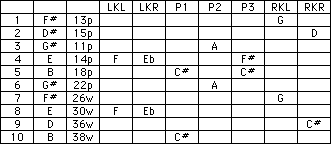
Scale Tone
|
5
|
b7
|
1
|
2 / 9
|
3
|
5
|
1
|
3
|
7
|
2 / 9
|
String
|
10
|
9
|
8
|
7
|
6
|
5
|
4
|
3
|
2
|
1
|
Note in E
|
B
|
D
|
E
|
F#
|
G#
|
B
|
E
|
G#
|
D#
|
F#
|